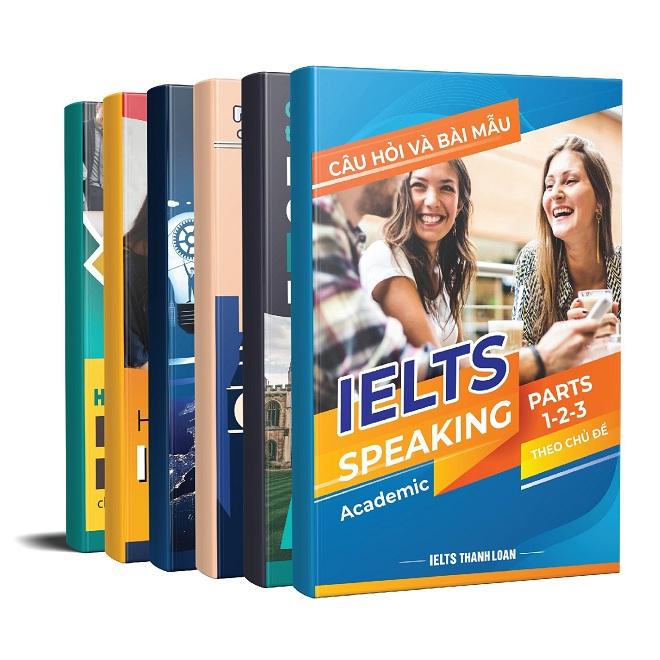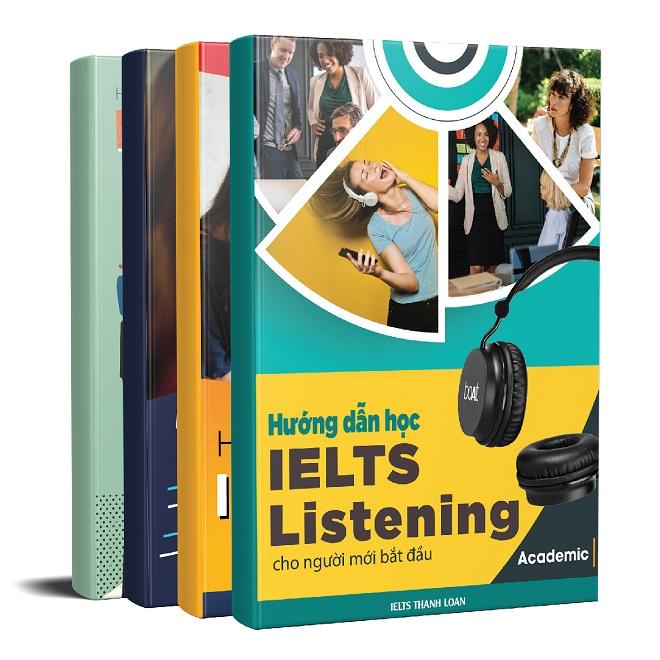Tự đánh giá năng lực IELTS Listening của mình qua Cambridge 13 Test 3 với transcript và đáp án đầy đủ nhất. Nếu bạn cần nâng cao kỹ năng và đạt điểm tốt nhất trong kỳ thi IELTS sắp tới, các khóa học luyện thi IELTS online và khóa học luyện thi IELTS cấp tốc, 1 kèm 1 tại IELTS Thanh Loan sẽ là lựa chọn lý tưởng để hiện thực hóa mục tiêu của bạn.
Đáp án IELTS Listening Cambridge 13 Test 3
| 1. 850 | 11. F | 21. C | 31. tongue(s) |
| 2. bike/ bicycle | 12. D | 22. A | 32. plants |
| 3. parking | 13. A | 23. A | 33. snakes |
| 4. 30/ thirty | 14. B | 24. B | 34. sky |
| 5. weekend(s) | 15. C | 25. C | 35. partner(s) |
| 6. cinema | 16. G | 26. F | 36. contact |
| 7. hospital | 17. B/C (in any order) | 27. H | 37. protection |
| 8. dentist | 18. C/B (in any order) | 28. D | 38. tail(s) |
| 9. Thursday | 19. B/D (in any order) | 29. A | 39. steps |
| 10. cafe | 20. D/B (in any order) | 30. E | 40. injury/ injuries |
Section 1: Moving to Banford city
1. Phân tích câu hỏi
Question 1 – 10:
Complete the notes below. Write ONE WORD OR A NUMBER.
|
Moving to Banford City(Chuyển đến thành phố Banford) Example Linda recommends living in suburb of: Dalton Accommodation
Transport
Chỗ ở
Vận chuyển
Advantages of living in Banford
Meet Linda
Thuận lợi khi sống ở Banford
Gặp Linda
|
2. Giải thích đáp án
Linda: Hello, Linda speaking
Xin chào, tôi là Linda đây ạ.
Matt: Oh hi Linda this is Matt Brooks. Alex White gave me your number. He said you’d be able to give me some advice about moving to Banford.
Ồ chào Linda, tôi là Matt Brooks. Anh Alex White đã cho tôi số của bạn. Anh ấy nói rằng bạn có thể cho tôi một số lời khuyên về việc chuyển đến thành phố Banford.
Linda: Yes, Alex did mention you. How can I help?
Ừ, Alex có nhắc đến bạn rồi. Thế tôi có thể giúp gì nhỉ?
Matt: Well, first of all, which area to live in?
Vâng, trước hết, tôi nên sống ở khu vực nào nhỉ?
Linda:Well I live in Dalton (Example), which is a really nice suburb, not too expensive and there’s a nice park.
Vâng, tôi sống ở Dalton, một vùng ngoại ô rất đẹp, không quá đắt đỏ và có một công viên khá đẹp nha.
Matt: Sounds good. Do you know how much it would be to rent a two-bedroom flat there?
Nghe hay đấy. Bạn có biết chi phí thuê căn hộ hai phòng ngủ ở đó bao nhiêu không vậy?
Linda: Yeah, you should be able to get something reasonable for 850 (Q2) pounds per month. That’s what people typically pay. You certainly wouldn’t want to pay more than 900 pounds. That doesn’t include bills or anything.
Vâng, bạn sẽ có thể nhận được một cái gì đó hợp lý cho 850 bảng Anh mỗi tháng. Đó là những gì mọi người thường trả. Bạn chắc chắn sẽ không muốn trả hơn 900 bảng Anh. Nó không bao gồm hóa đơn hay bất cứ thứ gì nha.
Matt: No, that sounds all right. I’ll definitely have a look there. Are the transport links easy from where you live?
Không, nghe có vẻ ổn nhỉ. Tôi chắc chắn sẽ nhìn sơ qua ở đó. Còn các phương tiện giao thông có dễ dàng từ nơi bạn sinh sống không vậy?
Linda: Well I’m very lucky. I work in the city center so I don’t have to use public transport. I go by bike (Q3).
Tôi rất may mắn nha. Tôi làm việc ở trung tâm thành phố nên tôi không phải sử dụng phương tiện công cộng. Tôi đi bằng xe đạp.
Matt: Oh I wish I could do that. Is it safe to cycle around the city?
Ồ, tôi ước tôi có thể làm điều đó. Vậy có an toàn để đạp xe đi vòng quanh thành phố không thế?
Linda: Yes, it’s fine and it keeps me fit. Anyway, driving to work in the city center would be a nightmare because there’s hardly any parking (Q4). And the traffic during the rush-hour can be bad.
Có, nó rất an toàn và nó giữ cho tôi khỏe mạnh. Dù sao đi nữa, lái xe đến đi làm ở trung tâm thành phố sẽ là một cơn ác mộng vì hầu như không có bất kỳ bãi đậu xe nào cả. Và lưu lượng giao thông trong giờ cao điểm có thể rất tồi tệ.
Matt: I’d be working from home but I’d have to go to London one or two days a week.
Tôi sẽ làm việc ở nhà nhưng tôi phải đến London một hoặc hai ngày một tuần.
Linda: Oh, that’s perfect! Getting to London is no problem. There’s a fast train every 30 minutes (Q5) which only takes 45 minutes.
À, đó là điều tuyệt vời! Đến London là không có vấn đề gì cả. Có một chuyến tàu nhanh 30 phút mỗi chuyến mà chỉ mất 45 phút thôi.
Matt: That’s good.
Tuyệt vời quá.
Linda:Yeah. The train service isn’t bad during the week and they run quite late at night. It’s weekends that are a problem (Q6). They’re always doing engineering work and you have to take a bus to Haddam and pick up the train there which is really slow. But other than that, Banford’s a great place to live. I’ve never been happier.
Ừ. Dịch vụ tàu không phải là xấu trong tuần làm việc và họ chạy khá muộn vào ban đêm. Vào những ngày cuối tuần đó là một vấn đề. Họ luôn làm công việc kỹ thuật và bạn phải đi xe buýt đến Haddam và bắt chuyến tàu ở đó mà có tốc độ rất chậm. Nhưng ngoài điều đó ra, thì thành phố Banford là một nơi tuyệt vời để sống. Tôi chưa bao giờ hạnh phúc hơn như nơi này.
Linda:There are some nice restaurants in the city center and a brand-new cinema which has only been open a couple of months (Q7). There’s a good art center too.
Có một vài nhà hàng ngon ở trung tâm thành phố và một rạp chiếu phim hoàn toàn mới mà chỉ mới được mở cửa một vài tháng à. Có một trung tâm trình chiếu nghệ thuật đẹp nữa.
Matt: Sounds like Bamford’s got it all.
Có vẻ như thành phố Bamford đã có tất cả nhỉ.
Linda: Yes, we’re really lucky. There are lots of really good aspects to living here. The schools are good and the hospital here is one of the best in the country (Q7). Everyone I know who’s been there’s had a positive experience. Oh, I can give you the name of my dentist too in Bridge street (Q8) if you’re interested. I’ve been going to him for years and I’ve never had any problems.
Vâng, chúng ta thực sự rất may mắn. Có rất nhiều khía cạnh thực sự tốt để sống ở đây. Các trường học là tốt và bệnh viện ở đây là một trong những bệnh viện tốt nhất trên cả nước nha. Mọi người tôi biết thì ai cũng có một trải nghiệm tích cực. À, tôi cũng có thể cho bạn tên bác nha sĩ của tôi ở phố Bridge nếu bạn quan tâm đến. Tôi đã đi khám ở chỗ anh ta trong nhiều năm và tôi đã không bao giờ có bất kỳ vấn đề gì cả.
Matt: Oh, okay, thanks.
À, ừ ừ, cảm ơn.
Linda: I’ll find his number and send it to you.
Tôi sẽ tìm số máy của anh ta và gửi nó cho bạn.
Matt: Thanks. That would be really helpful.
Cảm ơn nha. Nó thật sự rất hữu ích.
Linda: Are you planning to visit Banford soon?
Bạn có kế hoạch gì để đến thành phố Banford sớm không vậy?
Matt: Yes, my wife and I are both coming next week. We want to make some appointments with Estate agents.
Có chứ, vợ tôi và tôi đều đến vào tuần tới nha. Chúng tôi muốn đặt lịch một số cuộc hẹn với các đại lý bất động sản.
Linda: I could meet you if you like and show you around.
Tôi có thể giúp bạn nếu bạn muốn và dẫn bạn đi vòng lòng khắp nơi.
Matt: Are you sure? We’d really appreciate that.
Bạn chắc không? Chúng tôi thực sự trân trọng điều đó.
Linda: Either a Tuesday or Thursday is good for me. after 5:30 (Q9).
Vào một ngày thứ 3 hoặc thứ 5 thì rảnh đối với tôi. Sau 5 giờ 30 nha.
Matt: Thursday is preferable. Tuesday, I need to get home before 6:00 p.m.
Thứ 5 có vẻ thích hợp hơn. Thứ 3 thì tôi cần về nhà sớm trước 6 giờ tối.
Linda: Okay, great. Let me know which train you’re catching and I’ll meet you in the cafe outside. You can’t miss it. It’s opposite the station (Q10) and next to the museum.
Ừ tuyệt quá. Hãy cho tôi biết bạn bắt chuyến tàu nào và tôi sẽ gặp bạn ở quán cà phê bên ngoài. Bạn không thể bỏ lỡ nó đâu nha. Nó đối diện với nhà ga và cạnh bên bảo tàng.
Brilliant. I’ll text you next week then thanks so much for all the advice.
Tuyệt vời. Tôi sẽ nhắn tin cho bạn vào tuần tới và cảm ơn rất nhiều cho tất cả lời khuyên nha.
Linda: No problem, I’ll see you next week.
Không vấn đề gì cả, tôi sẽ gặp bạn vào tuần tới nha.
Mời bạn cùng tham gia cộng đồng “Học IELTS 0đ” trên Zalo cùng IELTS Thanh Loan, nhận những video bài giảng, tài liệu, dự đoán đề thi IELTS miễn phí và cập nhật
3. Từ vựng
- suburb (noun):
Nghĩa: an area where people live that is outside the centre of a city
Ví dụ: They live in the suburbs. - appointment (noun):
Nghĩa: a formal arrangement to meet or visit somebody at a particular time, especially for a reason connected with their work
Ví dụ: She has a doctor’s appointment in twenty minutes. - show somebody around (phrasal verb):
Nghĩa: to be a guide for somebody when they visit a place for the first time to show them what is interesting
Ví dụ: We were shown around the school by one of the students. - preferable (adj):
Nghĩa: more attractive or more suitable; to be preferred to something
Ví dụ: Anything was preferable to the tense atmosphere at home.
Học IELTS online hiệu quả, cam kết đầu ra tại Trung tâm tiếng Anh IELTS Thanh Loan
IELTS Thanh Loan – giáo viên 10 năm kinh nghiệm – trực tiếp đứng lớp, tự tin mang đến khóa học chất lượng nhất, phương pháp giảng dạy cô đọng dễ hiểu, giáo trình tự biên soạn cho lộ trình từ cơ bản đến luyện đề chuyên sâu. Đặc biệt, học viên luôn được quan tâm sát sao nhất, hỗ trợ không giới hạn, thúc đẩy kỷ luật học tập tốt để đạt mục tiêu.

Section 2
1. Phân tích câu hỏi
Questions 11-16: What advantages does the speaker mention for each of the following physical activities?
Choose SIX answers from the box and write the correct letter A-G next to questions 11-16
Physical Activities
|
Advantages
|
| Người nói đề cập đến những ưu điểm nào đối với mỗi hoạt động thể chất sau đây?
Chọn 6 câu trả lời từ ô và viết đúng chữ cái A-G bên cạnh câu hỏi 11-16 |
|
Ưu điểm
|
Các hoạt động thể chất
|
Questions 17 and 18: Choose TWO letters A-E.
For which TWO reasons does the speaker say people give up going to the gym?
- A. lack of time
- B. loss of confidence
- C. too much effort required
- D. high costs
- E. feeling less successful than others
→ Vì HAI lý do nào mà người nói nói rằng mọi người từ bỏ việc đi tập thể dục?
- A. thiếu thời gian
- B. mất tự tin
- C. cần quá nhiều nỗ lực
- D. chi phí cao
- E. cảm thấy kém thành công hơn những người khác
Questions 19 and 20: Choose TWO letters A-E.
Which TWO pieces of advice does the speaker give for setting goals?
- A. write goals down
- B. have achievable aims
- C. set a time limit
- D. give yourself rewards
- E. challenge yourself
→ Người nói đưa ra HAI lời khuyên nào để thiết lập mục tiêu?
- A. ghi mục tiêu xuống
- B. có những mục tiêu có thể đạt được
- C. đặt ra một giới hạn thời gian
- D. tự thưởng cho mình
- E. thử thách bản thân
2. Giải thích đáp án
So if you’re one of those people who hasn’t found the perfect physical activity yet – here are some things to think about which might help you make the right decision for you.
Nếu bạn là một trong những người chưa tìm thấy hoạt động thể chất hoàn hảo – thì đây là một số điều cần suy nghĩ có thể giúp bạn đưa ra quyết định đúng đắn cho mình.
The first question to ask yourself is whether you would enjoy training in a gym. Many people are put off by the idea of having to fit a visit to the gym into their busy day – you often have to go very early or late as some gyms can get very crowded. But with regular training you’ll see a big difference in a relatively short space of time (Q11).
Câu hỏi đầu tiên để tự hỏi bản thân là liệu bạn có thích tập luyện trong phòng tập hay không. Nhiều người không muốn đến phòng tập thể dục vào một ngày bận rộn của họ – bạn thường phải đi rất sớm hoặc muộn vì một số phòng tập có thể rất đông. Nhưng với việc luyện tập thường xuyên, bạn sẽ thấy sự khác biệt lớn trong một khoảng thời gian tương đối ngắn.
Running has become incredibly popular in recent years. That’s probably got a lot to do with the fact that it’s a very acessible form of exercise – anyone can run – even if you can only run a few metres to begin with (Q12). But make sure you get the right shoes – it’s worth investing in a high quality pair and they don’t come cheap. Another great thing about running is that you can do it at any time of day or night – the only thing that may stop you is snow and ice.
Chạy bộ đã trở nên vô cùng phổ biến trong những năm gần đây. Điều đó có lẽ liên quan nhiều đến thực tế là đây là một hình thức tập thể dục rất dễ tiếp cận – ai cũng có thể chạy – ngay cả khi bạn chỉ có thể chạy vài mét để bắt đầu. Nhưng hãy đảm bảo rằng bạn mua được đôi giày phù hợp – thực sự rất đáng đầu tư vào một đôi chất lượng cao và chúng không hề rẻ. Một điều tuyệt vời khác của việc chạy bộ là bạn có thể thực hiện bất cứ lúc nào trong ngày hay đêm – điều duy nhất có thể ngăn cản bạn là băng tuyết.
Swimming is another really good way to build fitness. What attracts many people is that you can swim in an indoor pool at any time of year (Q13). On the other hand, it can be quite boring or solitary – it’s hard to chat to people while you’re swimming lengths.
Bơi lội là một cách thực sự tốt khác để xây dựng thể lực. Điều thu hút nhiều người là bạn có thể bơi ở bể bơi trong nhà vào bất kỳ thời điểm nào trong năm. Mặt khác, nó có thể khá nhàm chán hoặc đơn độc – thật khó để trò chuyện với mọi người trong khi bạn đang bơi.
| Từ vựng trong câu hỏi và đáp án | Từ vựng trong hội thoại | |
| Q11. F | fast results | see a big difference in a relatively short space of time |
| Q12. D | fitness level unimportant | a very accessible form of exercise – anyone can run |
| Q13. A | not dependent on season | swim in an indoor pool at any time of year |
| Q14. B | enjoyable | many people say being out in the fresh air in a park or in the countryside can be fun |
| Q15. C | low risk of injury | less chance of hurting yourself than with other more active sports |
| Q16. G | motivating | encourage you and help you achieve your goals |
| Q17/18.
B & C |
loss of confidence | give up hope and stop believing |
| too much effort required | takes a lot of determination and hard work to keep training | |
| Q19/20.
B & D |
have achievable aims | be realistic and don’t push yourself too far |
| give yourself rewards | Give yourself a really nice treat every time you reach one of your goals |
3. Từ vựng
- accessible (adjective):
Nghĩa: that can be reached, entered, used, seen, etc.
Ví dụ: These documents are not accessible to the public. - solitary (adjective):
Nghĩa: done alone; without other people
Ví dụ: She enjoys long solitary walks. - challenging (adjective):
Nghĩa: difficult in an interesting way that tests your ability
Ví dụ: I have had a challenging and rewarding career as a teacher.. - make use of something/ somebody (idiom):
Nghĩa: to use something/somebody, especially in order to get an advantage
Ví dụ: We could make better use of our resources. - determination (uncountable noun):
Nghĩa: the quality that makes you continue trying to do something even when this is difficult
Ví dụ: I admire her determination to get it right. - treat (noun):
Nghĩa: something very pleasant that somebody can enjoy, especially something that you give somebody or do for them
Ví dụ: When I was young chocolate was a treat.
Tự học IELTS tại nhà chỉ từ 1.2 triệu?
Tham khảo ngay Khóa học IELTS Online dạng video bài giảng
Giải pháp tự học IELTS tại nhà, tiết kiệm chi phí, linh hoạt thời gian nhưng đảm bảo hiệu quả. Khóa học dạng video bài giảng có lộ trình học từng ngày chi tiết. Học viên học lý thuyết qua video bài giảng, thực hành Listening Reading trực tiếp trên website, còn Writing Speaking được chấm chữa trực tiếp bởi cô Thanh Loan. Mọi bài giảng đều có tài liệu học tập đi kèm.

Section 3: Project on using natural dyes to color fabrics
1. Phân tích câu hỏi
Questions 21-24: Choose the correct letter A, B or C.
21. What first inspired Jim to choose this project?
- A. textiles displayed in an exhibition
- B. a book about a botanic garden
- C. carpets he saw on holiday
→ Điều gì đã thôi thúc Jim chọn dự án này?
- A. hàng dệt được trưng bày trong một cuộc triển lãm
- B. một cuốn sách về một khu vườn thực vật
- C. những tấm thảm anh ấy nhìn thấy vào kỳ nghỉ
Chú ý đến cụm từ “first inspired”
22. Jim eventually decided to do a practical investigation which involved
- A. using a range of dyes with different fibres
- B. applying different dyes to one type of fibre
- C. testing one dye and a range of fibres
→ Jim cuối cùng đã quyết định thực hiện một cuộc điều tra thực tế liên quan đến
- A. sử dụng nhiều loại thuốc nhuộm với các sợi khác nhau
- B. áp dụng các loại thuốc nhuộm khác nhau cho một loại sợi
- C. thử nghiệm một loại thuốc nhuộm và một loạt các loại sợi
Chú ý đến cụm từ “eventually decided a practical investigation”
23. When doing his experiments Jim was surprised by
- A. how much natural material was needed to make the dye
- B. the fact that dyes were widely available on the internet
- C. the time that he had to leave the fabric in the dye
→ Khi thực hiện thí nghiệm của mình, Jim đã rất ngạc nhiên bởi
- A. cần bao nhiêu nguyên liệu tự nhiên để làm thuốc nhuộm
- B. thực tế là thuốc nhuộm đã được phổ biến rộng rãi trên internet
- C. là thời gian mà anh ta phải để vải trong thuốc nhuộm
Chú ý đến cụm từ “surprised by”
24. What problem did Jim have with using tartrazine as a fabric dye?
- A. it caused a slight allergic reaction
- B. it was not a permanent dye on cotton
- C. it was ineffective when used on nylon
→ Jim đã gặp vấn đề gì khi sử dụng tartrazine làm thuốc nhuộm vải?
- A. nó gây ra một phản ứng dị ứng nhẹ
- B. nó không phải là thuốc nhuộm bền màu trên bông
- C. nó không hiệu quả khi sử dụng trên nylon
Chú ý đến cụm từ “problem”
Questions 25-30:
What problem is identified with each of the following natural dyes?
Choose SIX answers from the options below and write correct letter A-H next to questions 25-30
Problems
- A. it is expensive
- B. the color is too strong
- C. the color is not long lasting
- D. it is very poisonous
- E. it can damage the fabric
- F. the color may be unexpected
- G. it is unsuitable for some fabrics
- H. it is not generally available
Natural dyes
- 25. Turmeric
- 26. Beetroot
- 27. Tyrian purple
- 28. Lowood
- 29. Cochineal
- 30. Metal oxide
Vấn đề nào được xác định với mỗi loại thuốc nhuộm tự nhiên sau đây?
Chọn SÁU câu trả lời từ các tùy chọn bên dưới và viết đúng chữ cái A-H bên cạnh các câu hỏi 25-30
Các vấn đề
- A. nó đắt
- B. màu quá mạnh
- C. màu không lâu trôi
- D. nó rất độc
- E. nó có thể làm hỏng vải
- F. màu có thể bất ngờ
- G. nó không phù hợp với một số loại vải
- H. nó thường không có sẵn
Thuốc nhuộm tự nhiên
- 25. Nghệ
- 26. Củ cải đường
- 27. Màu tím Tyrian
- 28. Lowood
- 29. Cochineal
- 30. Oxit kim loại
🡪 Lưu ý là có 2 lựa chọn sẽ không là đáp án cho câu hỏi nào.
Sách luyện đề IELTS 4 kỹ năng sát thật nhất:
2. Giải thích đáp án
TUTOR: OK, Jim. You wanted to see me about your textile design project.
Được rồi, Jim. Bạn muốn gặp tôi về dự án thiết kế dệt may của bạn đúng không.
JIM: That’s right. I’ve been looking at how a range of natural dyes can be used to colour fabrics like cotton and wool.
Dạ vâng. Em đã xem xét cách một loạt các loại thuốc nhuộm tự nhiên có thể được sử dụng để tạo màu cho các loại vải như bông và len.
TUTOR: Why did you choose that topic?
Tại sao bạn lại chọn chủ đề đó?
JIM: Well, I got a lot of useful ideas from the museum, you know, at that exhibition of textiles. But I’ve always been interested in anything to do with colour. Years ago, I went to a carpet shop with my parents when we were on holiday in Turkey, and I remember all the amazing colours (Q21).
Chà, em có rất nhiều ý tưởng hữu ích từ bảo tàng tại triển lãm dệt may đó. Nhưng em luôn quan tâm đến bất cứ điều gì liên quan đến màu sắc. Cách đây nhiều năm, em đã đến một cửa hàng bán thảm với bố mẹ khi nhà em đi nghỉ ở Thổ Nhĩ Kỳ, và em nhớ tất cả các màu sắc tuyệt vời đó.
TUTOR: They might not all have been natural dyes.
Chúng có thể không phải là thuốc nhuộm tự nhiên
JIM: Maybe not, but for the project I decided to follow it up. And I found a great book about a botanic garden in California that specialises in plants used for dyes.
Có lẽ không, nhưng đối với dự án, em quyết định theo dõi nó. Và em đã tìm thấy một cuốn sách tuyệt vời về một khu vườn thực vật ở California chuyên về các loại cây dùng làm thuốc nhuộm rồi.
TUTOR: OK. So, in your project, you had to include a practical investigation.
Được. Vậy, trong dự án của bạn, bạn phải bao gồm một cuộc điều tra thực tế.
JIM: Yeah. At first I couldn’t decide on my variables. I was going to just look at one type of fibre for example, like cotton …
Vâng. Lúc đầu, em không thể quyết định được về các biến của mình. Em sẽ chỉ xem xét một loại sợi, chẳng hạn như bông …
TUTOR: … and see how different types of dyes affected it?
… và xem các loại thuốc nhuộm khác nhau đã ảnh hưởng đến nó như thế nào?
JIM: Yes. Then I decided to include others as well, so I looked at cotton and wool and nylon (Q22).
Vâng. Sau đó, em quyết định bao gồm cả những chất liệu khác, vì vậy em đã xem xét bông, len và nylon.
TUTOR: With just one type of dye?
Chỉ với một loại thuốc nhuộm?
JIM: Various types (Q22), including some that weren’t natural, for comparison.
Nhiều loại khác nhau, bao gồm một số loại không tự nhiên, để so sánh.
TUTOR: OK.
ĐỒNG Ý.
JIM: So, I did the experiments last week. I used some ready-made natural dyes, I found a website which supplied them, they came in just a few days, but I also made some of my own.
Em đã thực hiện các thí nghiệm vào tuần trước. Em đã sử dụng một số thuốc nhuộm tự nhiên làm sẵn, và em tìm thấy một trang web cung cấp chúng, chúng đến chỉ trong vài ngày, nhưng em cũng đã tự làm một trong số chúng.
TUTOR: That must have taken quite a bit of time.
Điều đó phải mất khá nhiều thời gian.
JIM: Yes, I’d thought it’d just be a matter of a teaspoon or so of dye, and actually that wasn’t the case at all. Like I was using one vegetable, beetroot, for a red dye, and I had to chop up a whole pile of it (Q23). So it all took longer than I’d expected.
Vâng, em đã nghĩ rằng nó chỉ là vấn đề của một thìa cà phê thuốc nhuộm, và thực sự là hoàn toàn không phải như vậy. Giống như em đang sử dụng một loại rau, củ dền, để nhuộm màu đỏ, và em phải băm nhỏ cả đống. Vì vậy, tất cả mất nhiều thời gian hơn em mong đợi.
TUTOR: One possibility is to use food colourings.
Một khả năng là sử dụng chất tạo màu thực phẩm.
JIM: I did use one. That was a yellow dye, an artificial one.
Em đã sử dụng nó. Đó là một loại thuốc nhuộm màu vàng, một loại thuốc nhuộm nhân tạo.
TUTOR: Tartrazine?
Tartrazine?
JIM: Yeah. I used it on cotton first. It came out a great colour, but when I rinsed the material, the colour just washed away (Q24). I’d been going to try it out on nylon, but I abandoned that idea.
Vâng. Em đã sử dụng nó trên bông đầu tiên. Nó tạo ra một màu sắc tuyệt vời, nhưng khi em rửa vật liệu, màu chỉ bị trôi đi. Em đã định thử nó trên nylon, nhưng em đã từ bỏ ý định đó.
TUTOR: Were you worried about health issues?
Bạn có lo lắng về các vấn đề sức khỏe?
JIM: I’d thought if it’s a legal food colouring, it must be safe.
Em đã nghĩ nếu đó là màu thực phẩm hợp pháp, nên nó phải an toàn.
TUTOR: Well, it can occasionally cause allergic reactions, I believe.
Tôi tin rằng đôi khi nó có thể gây ra phản ứng dị ứng.
TUTOR: So what natural dyes did you look at?
Vậy, bạn đã xem xét những màu thuốc tự nhiên nào?
JIM: Well, one was turmeric. The colour’s great, it’s a really strong yellow. It’s generally used in dishes like curry.
Vâng, một là nghệ. Màu sắc tuyệt vời, nó là một màu vàng thực sự đậm. Nó thường được sử dụng trong các món ăn như cà ri.
TUTOR: It’s meant to be quite good for your health when eaten, but you might find it’s not permanent when it’s used as a dye – a few washes, and it’s gone (Q25).
Nó có nghĩa là khá tốt cho sức khỏe của bạn khi ăn, nhưng bạn có thể thấy nó không lâu dài khi nó được sử dụng làm thuốc nhuộm – chỉ một vài lần rửa thôi là nó biến mất.
JIM: Right. I used beetroot as a dye for wool. When I chop up beetroot to eat I always end up with bright red hands, but the wool ended up just a sort of watery cream shade (Q26). Disappointing.
Đúng. Em đã sử dụng củ dền làm thuốc nhuộm cho len. Khi em cắt củ dền để ăn, bàn tay lúc nào cũng đỏ tươi, nhưng cuối cùng sợi len chỉ là một loại màu kem bóng nước. Thật đáng thất vọng.
TUTOR: There’s a natural dye called Tyrian purple. Have you heard of that?
Có một loại thuốc nhuộm tự nhiên được gọi là màu tím Tyrian. Bạn đã nghe nói về điều đó?
JIM: Yes. It comes from a shellfish, and it was worn in ancient times but only by important people as it was so rare. I didn’t use it (Q27).
Có ạ. Nó đến từ một loài động vật có vỏ, và nó đã được đeo vào thời cổ đại nhưng chỉ dành cho những người quan trọng vì nó rất hiếm. Em đã không sử dụng nó.
TUTOR: It fell out of use centuries ago, though one researcher managed to get hold of some recently. But that shade of purple can be produced by chemical dyes nowadays. Did you use any black dyes?
Nó đã không còn được sử dụng từ nhiều thế kỷ trước, mặc dù một nhà nghiên cứu đã tìm cách nắm bắt một số gần đây. Nhưng màu tím đó ngày nay có thể được tạo ra bằng thuốc nhuộm hóa học. Bạn đã sử dụng thuốc nhuộm đen nào chưa?
JIM: Logwood. That was quite complicated. I had to prepare the fabric so the dye would take.
Cây vang ạ. Điều đó khá phức tạp. Em đã phải chuẩn bị vải để thuốc nhuộm sẽ mất.
TUTOR: I hope you were careful to wear gloves.
Tôi hy vọng bạn đã cẩn thận để đeo găng tay.
JIM: Yes. I know the danger with that dye.
Có chứ ạ. Em biết mối nguy hiểm với thuốc nhuộm đó.
TUTOR: Good. It can be extremely dangerous if it’s ingested (Q28). Now, presumably you had a look at an insect-based dye? Like cochineal, for example?
Tốt. Nó có thể cực kỳ nguy hiểm nếu ăn phải. Bây giờ, có lẽ bạn đã xem một loại thuốc nhuộm dựa trên côn trùng? Như cochineal chẳng hạn?
JIM: Yes. I didn’t actually make that, I didn’t have time to start crushing up insects to get the red colour and anyway they’re not available here, but I managed to get the dye quite easily from a website. But it cost a fortune (Q29). I can see why it’s generally just used in cooking, and in small quantities.
Vâng. Em không thực sự làm được điều đó, em không có thời gian bắt đầu nghiền nát côn trùng để có màu đỏ và dù sao thì chúng cũng không có sẵn ở đây, nhưng em đã tìm cách lấy thuốc nhuộm khá dễ dàng từ một trang web. Nhưng nó rất tốn kém. Em có thể hiểu tại sao nó thường chỉ được sử dụng trong nấu ăn và với số lượng nhỏ.
TUTOR: Yes, it’s very effective, but that’s precisely why it’s not used as a dye.
Đúng, nó rất hiệu quả, nhưng đó chính là lý do tại sao nó không được sử dụng làm thuốc nhuộm.
JIM: I also read about using metal oxide. Apparently you can allow iron to rust while it’s in contact with the fabric, and that colours it.
Em cũng đọc về việc sử dụng oxit kim loại. Rõ ràng bạn có thể để sắt bị gỉ khi nó tiếp xúc với vải và điều đó sẽ tạo màu cho nó.
TUTOR: Yes, that works well for dying cotton. But you have to be careful as the metal can actually affect the fabric (Q30) and so you can’t expect to get a lot of wear out of fabrics treated in this way. And the colours are quite subtle, not everyone likes them. Anyway, it looks as if you’ve done a lot of work …
Có, nó hoạt động tốt cho bông chết. Nhưng bạn phải cẩn thận vì kim loại thực sự có thể ảnh hưởng đến vải và vì vậy bạn không thể mong đợi vải bị mòn nhiều được xử lý theo cách này. Và màu sắc khá tinh tế không phải ai cũng thích. Dù sao thì, có vẻ như bạn đã làm rất nhiều việc …
Answer
| Từ vựng trong câu hỏi và đáp án | Từ vựng trong hội thoại | |
| Q21. C | carpets he saw on holiday | went to a carpet shop with my parents when we were on holiday in Turkey, and I remember all the amazing colours |
| Q22. A | using a range of dyes different fibres |
With just one type of dye? Various types to include others as well, so I looked at cotton and wool and nylon |
| Q23. A | how much natural material was needed to make the dye | using one vegetable, beetroot, for a red dye, and I had to chop up a whole pile of it |
| Q24. B | was not a permanent dye on cotton | I rinsed the material, the colour just washed away |
| Q25. C | color is not long lasting | find it’s not permanent when it’s used as a dye – a few washes, and it’s gone |
| Q26. F | color may be unexpected | wool ended up just a sort of watery cream shade. Disappointing |
| Q27. H | not generally available | was so rare. I didn’t use it |
| Q28. D | very poisonous | can be extremely dangerous if it’s ingested |
| Q29. A | expensive | cost a fortune |
| Q30. E | can damage the fabric | metal can actually affect the fabric |
3. Từ vựng
- fabric (noun):
Nghĩa: material made by weaving wool, cotton, silk, etc., used for making clothes, curtains, etc. and for covering furniture
Ví dụ: They sell a wide variety of printed cotton fabric. - investigation (noun):
Nghĩa: an official examination of the facts about a situation, crime, etc.
Ví dụ: The authorities have launched an investigation to determine why the ferry sank. - decide on (phrasal verb):
Nghĩa: to choose something from a number of possibilities
Ví dụ: I can’t decide on who to invite. - colouring (noun):
Nghĩa: a substance that is used to give a particular colour to food
Ví dụ: Contains no artificial colouring or flavouring. - rinse something (verb):
Nghĩa: to wash something with clean water only, not using soap
Ví dụ: Rinse the cooked pasta with boiling water. - allergic (to something) (adj):
Nghĩa: having an allergy to something
Ví dụ: I like cats but unfortunately I’m allergic to them. - ingest something (verb):
Nghĩa: to take food, drugs, etc. into your body
Ví dụ: Grazing animals ingest dioxins through eating contaminated plants. - get hold of something (idiom):
Nghĩa: to obtain something
Ví dụ: Where can I get hold of today’s newspaper? - cost a fortune (collocation):
Nghĩa: cost an extremely large amount of money, expensive
Ví dụ: The cars on this list won’t cost a fortune to insure.
Tài liệu IELTS nào phù hợp với band 6.0+
Combo 6 cuốn sách luyện đề IELTS sát thật, tỉ lệ trúng tủ cao
- Dịch song ngữ, giải chi tiết IELTS Listening & Reading Cam 7-20
- Hơn 100 bài mẫu IELTS Writing Task 1 & 2 band 7.0+ đa dạng chủ đề
- Bài mẫu Speaking Part 1-2-3 cho 56 chủ đề thường gặp
Đảm bảo đây là bộ sách luyện đề IELTS sát thật, dễ đọc, và chi tiết nhất dành riêng cho sĩ tử IELTS Việt Nam.

Section 4: The sleepy lizard (Tiliqua Rugosa)
1. Phân tích câu hỏi
Questions 31-40:
Complete the notes below. Write ONE WORD ONLY for each answer.
|
The sleepy lizard (tiliqua rugosa) Description
Sự miêu tả
Navigation study
Observations in the wild
Nghiên cứu điều hướng
Quan sát trong tự nhiên
What people want Possible reasons:
Những gì mọi người muốn Lý do có thể:
Tracking study
Theo dõi nghiên cứu
|
2. Giải thích đáp án
Last week, we started looking at reptiles, including crocodiles and snakes. Today, I’d like us to have a look at another reptile – the lizard- and in particular, at some studies that have been done on a particular type of lizard whose Latin name is tiliqua rugosa. This is commonly known as the sleepy lizard, because it’s quite slow in its movements and spends quite a lot of its time dozing under rocks or lying in the sun.
Tuần trước, chúng ta bắt đầu xem xét các loài bò sát, bao gồm cả cá sấu và rắn. Hôm nay, tôi muốn chúng ta xem xét một loài bò sát khác – loài thằn lằn – và đặc biệt, về một số nghiên cứu đã được thực hiện trên một loại thằn lằn cụ thể có tên Latinh là tiliqua rugosa. Loài này thường được gọi là thằn lằn ngủ, vì nó di chuyển khá chậm và dành khá nhiều thời gian để ngủ gật dưới đá hoặc nằm dưới ánh nắng mặt trời.
I’ll start with a general description. Sleepy lizards live in Western and South Australia, where they’re quite common. Unlike European lizards, which are mostly small, green and fast-moving, sleepy lizards are brown, but what’s particularly distinctive about them is the colour of their tongue, which is dark blue (Q31), in contrast with the lining of their mouth which is bright pink. And they’re much bigger than most European lizards. They have quite a varied diet, including insects and even small animals, but they mostly eat plants of varying kinds (Q32).
Tôi sẽ bắt đầu với một mô tả chung. Thằn lằn ngủ sống ở Tây và Nam Úc, nơi chúng khá phổ biến. Không giống như thằn lằn châu Âu, hầu hết đều nhỏ, màu xanh lá cây và di chuyển nhanh, thằn lằn ngủ có màu nâu, nhưng điều đặc biệt ở chúng là màu sắc của lưỡi, màu xanh đậm, trái ngược với niêm mạc miệng có màu hồng tươi. Và chúng lớn hơn nhiều so với hầu hết các loài thằn lằn châu Âu. Chúng có chế độ ăn uống khá đa dạng, bao gồm cả côn trùng và thậm chí cả động vật nhỏ, nhưng chúng chủ yếu ăn thực vật với nhiều loại khác nhau.
Even though they’re quite large and powerful, with strong jaws that can crush beetles and snail shells, they still have quite a few predators. Large birds like cassowaries were one of the main ones in the past, but nowadays they’re more likely to be caught and killed by snakes (Q33). Actually, another threat to their survival isn’t a predator at all, but is man-made – quite a large number of sleepy lizards are killed by cars when they’re trying to cross highways.
Mặc dù chúng khá to lớn và mạnh mẽ, với bộ hàm khỏe có thể nghiền nát bọ cánh cứng và vỏ ốc, chúng vẫn có khá nhiều kẻ săn mồi. Trước đây, những loài chim lớn như chim dài là một trong những loài chính, nhưng ngày nay chúng có nhiều khả năng bị rắn bắt và giết hơn. Trên thực tế, một mối đe dọa khác đối với sự tồn tại của chúng hoàn toàn không phải là động vật ăn thịt, mà là do con người tạo ra – một số lượng lớn thằn lằn ngủ bị ô tô đâm khi chúng cố băng qua đường cao tốc.
Answer
| Từ vựng trong câu hỏi và đáp án | Từ vựng trong hội thoại | |
| Q31. tongue(s) |
|
|
| Q32. plants |
|
|
| Q33. snakes |
|
|
| Q34. sky |
|
|
| Q35. partner(s) |
|
|
| Q36. contact |
|
|
| Q37. protection |
|
|
| Q38. tail(s) |
|
|
| Q39. steps |
|
|
| Q40. injuries/ injury |
|
|
3. Từ vựng
- distinctive (adj):
Nghĩa: having a quality or characteristic that makes something different and easily noticed
Ví dụ: The male bird has distinctive white markings on its head. - predator (noun):
Nghĩa: an animal that kills and eats other animals
Ví dụ: Some animals have no natural predators. - monogamous (adj):
Nghĩa: having a sexual relationship with only one partner at a particular time
Ví dụ: Most birds are monogamous. - hatch (out) (verb):
Nghĩa: (of a young bird, fish, insect, etc.) to come out of an egg
Ví dụ: Ten chicks hatched (out) this morning. - avoidance (of something) (uncountable noun):
Nghĩa: not doing something; preventing something from existing or happening
Ví dụ: A person’s health improves with the avoidance of stress. - hypothesis (noun):
Nghĩa: an idea or explanation of something that is based on a few known facts but that has not yet been proved to be true or correct
Ví dụ: There is little evidence to support these hypotheses. - track (verb):
Nghĩa: to follow the movements of somebody/something, especially by using special electronic equipment
Ví dụ: We continued tracking the plane on our radar.
Mới bắt đầu học IELTS, sách ôn thi IELTS nào tốt?
Combo 4 cuốn Hướng dẫn tự học IELTS dành riêng cho người Việt
- Listening & Reading: Tiếp cận IELTS theo từng dạng câu hỏi, chia sẻ chiến thuật làm bài, mẹo hay cho từng dạng, và bài tập thực hành theo dạng.
- Writing: Hướng dẫn chi tiết cách viết câu – đoạn – bài văn và nhiều templates phong phú, rất dễ áp dụng
- Speaking: Cấu trúc câu trả lời tốt cho Speaking Part 1-2-3 kèm từ vựng phổ biến
Chắc chắn đây là bộ sách cực dễ đọc và dễ áp dụng cho sĩ tử IELTS Việt Nam.














